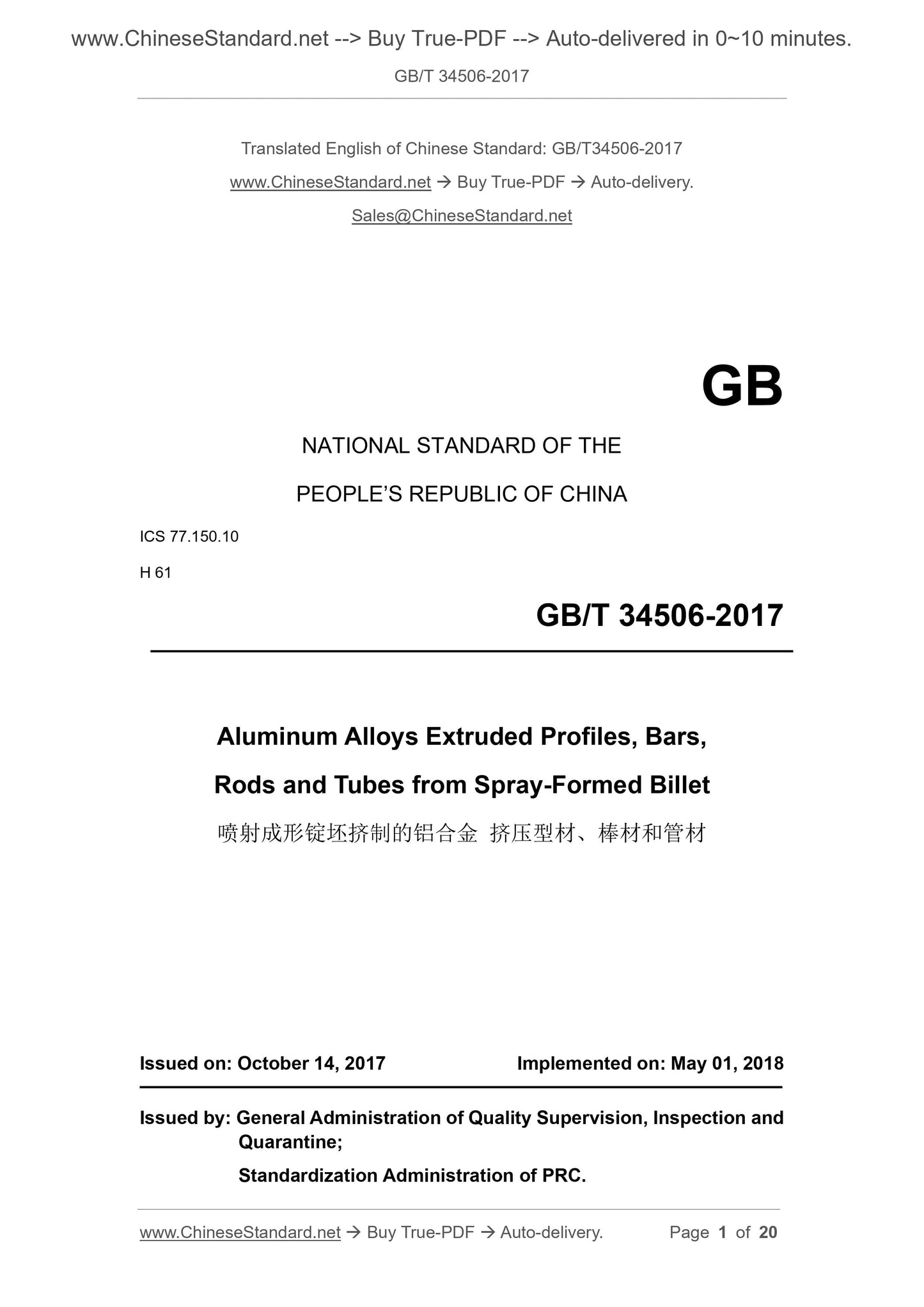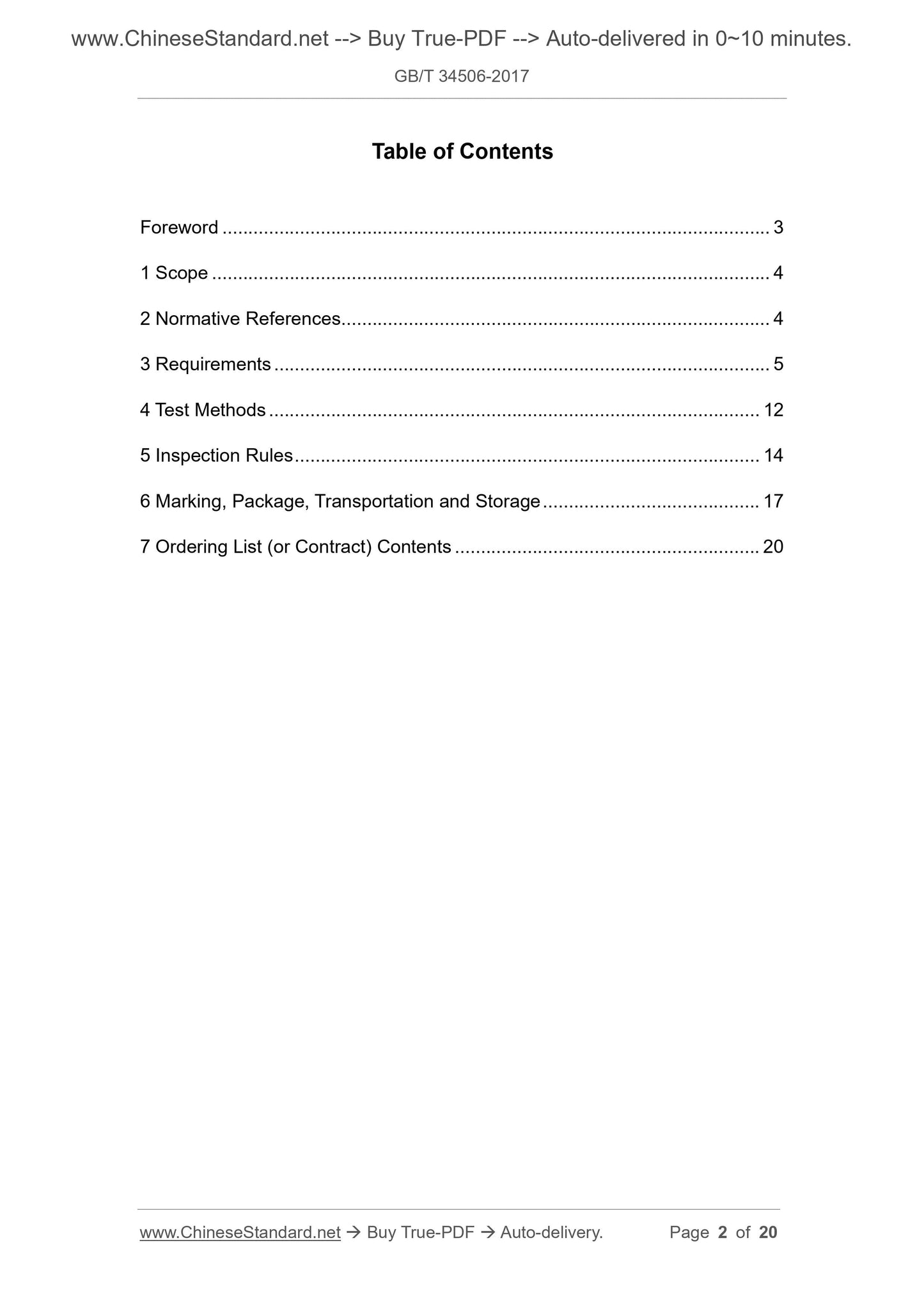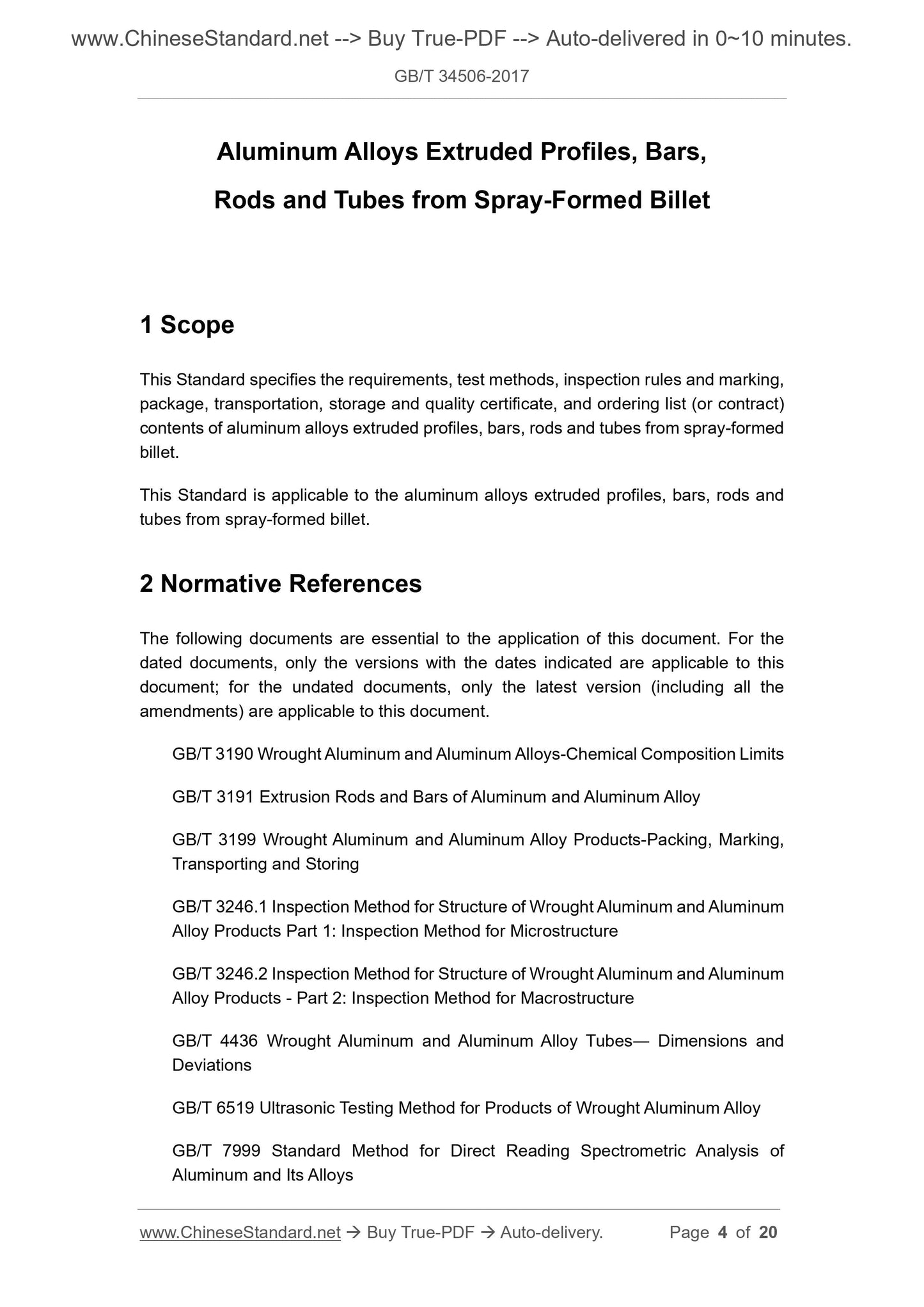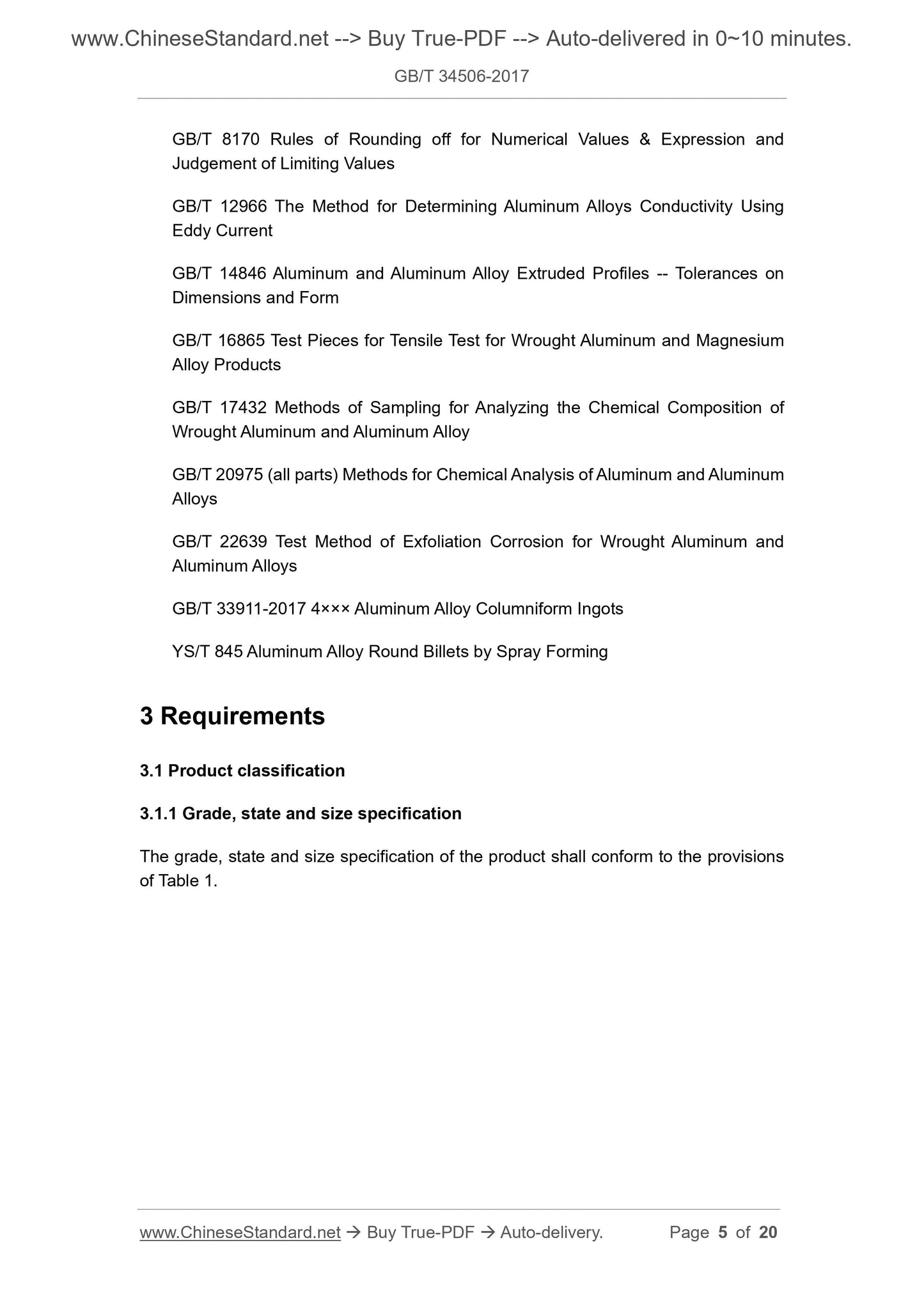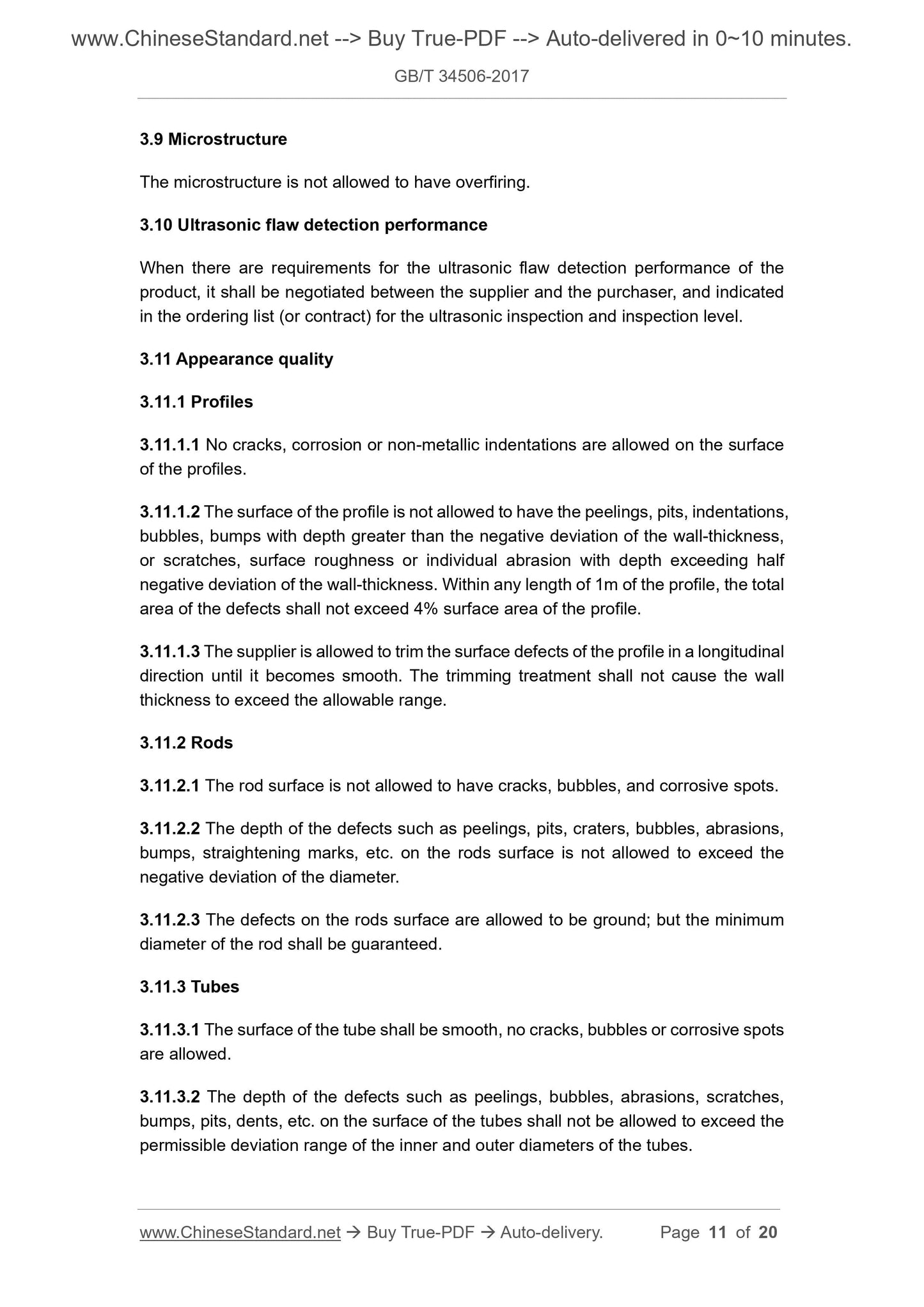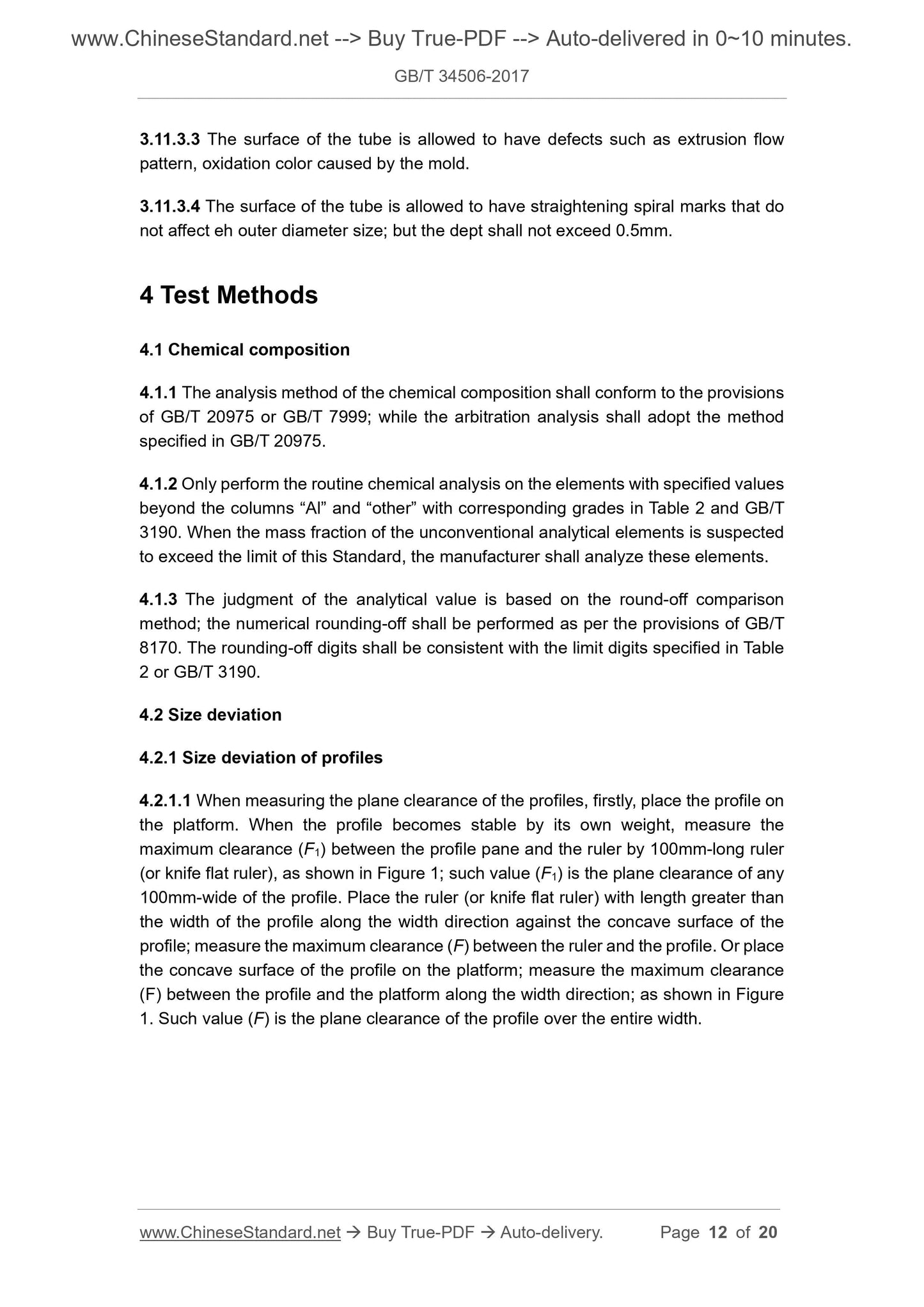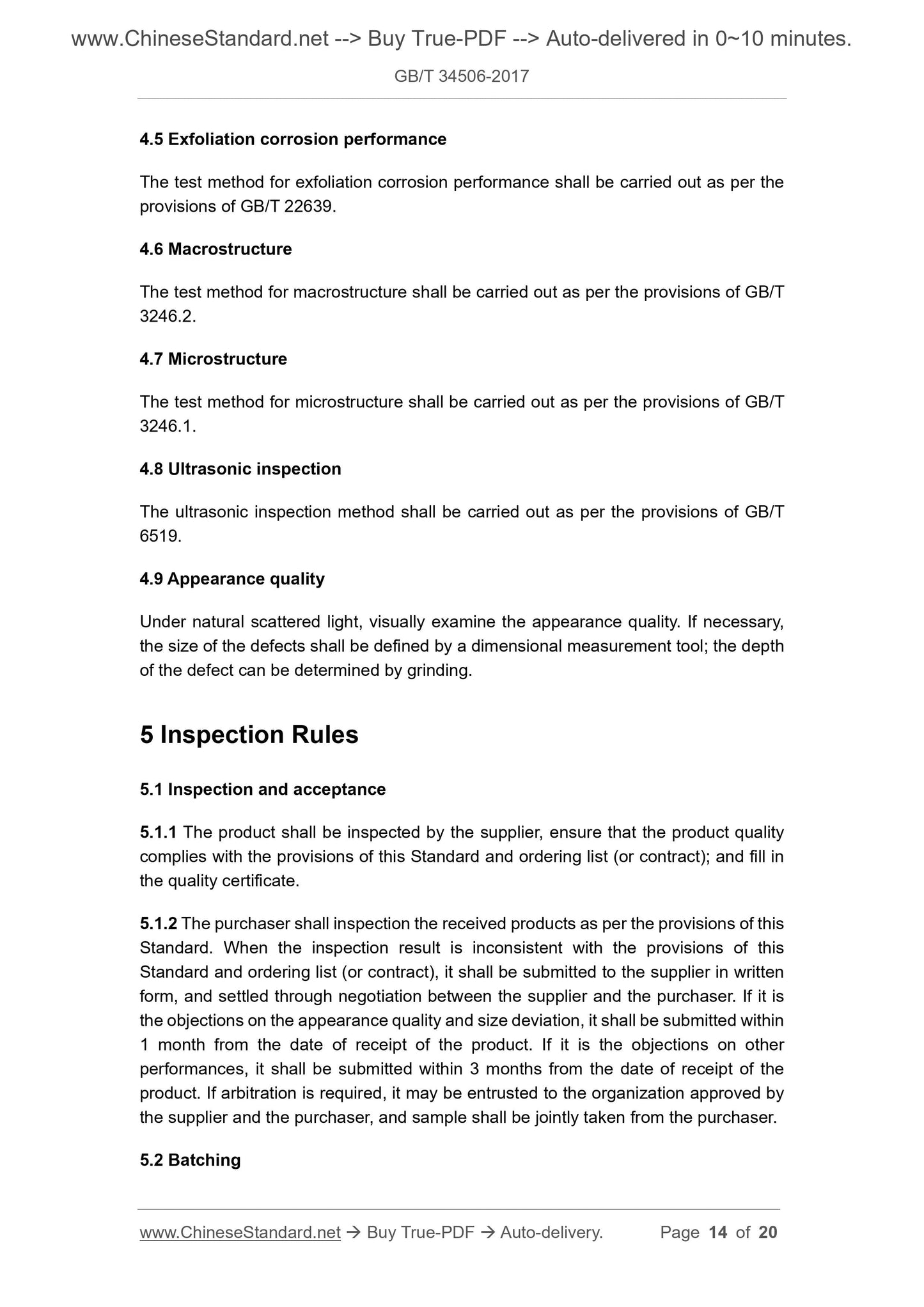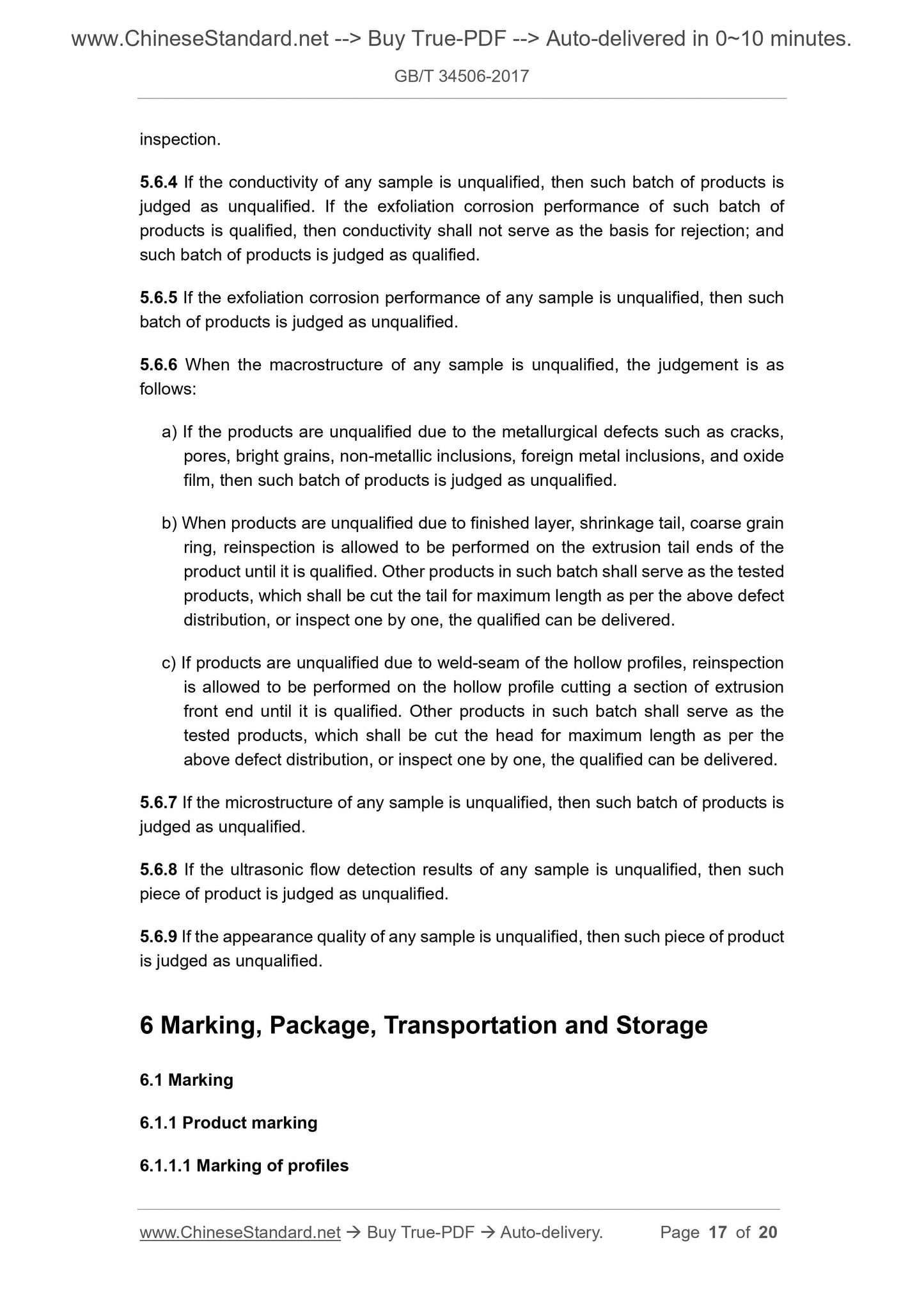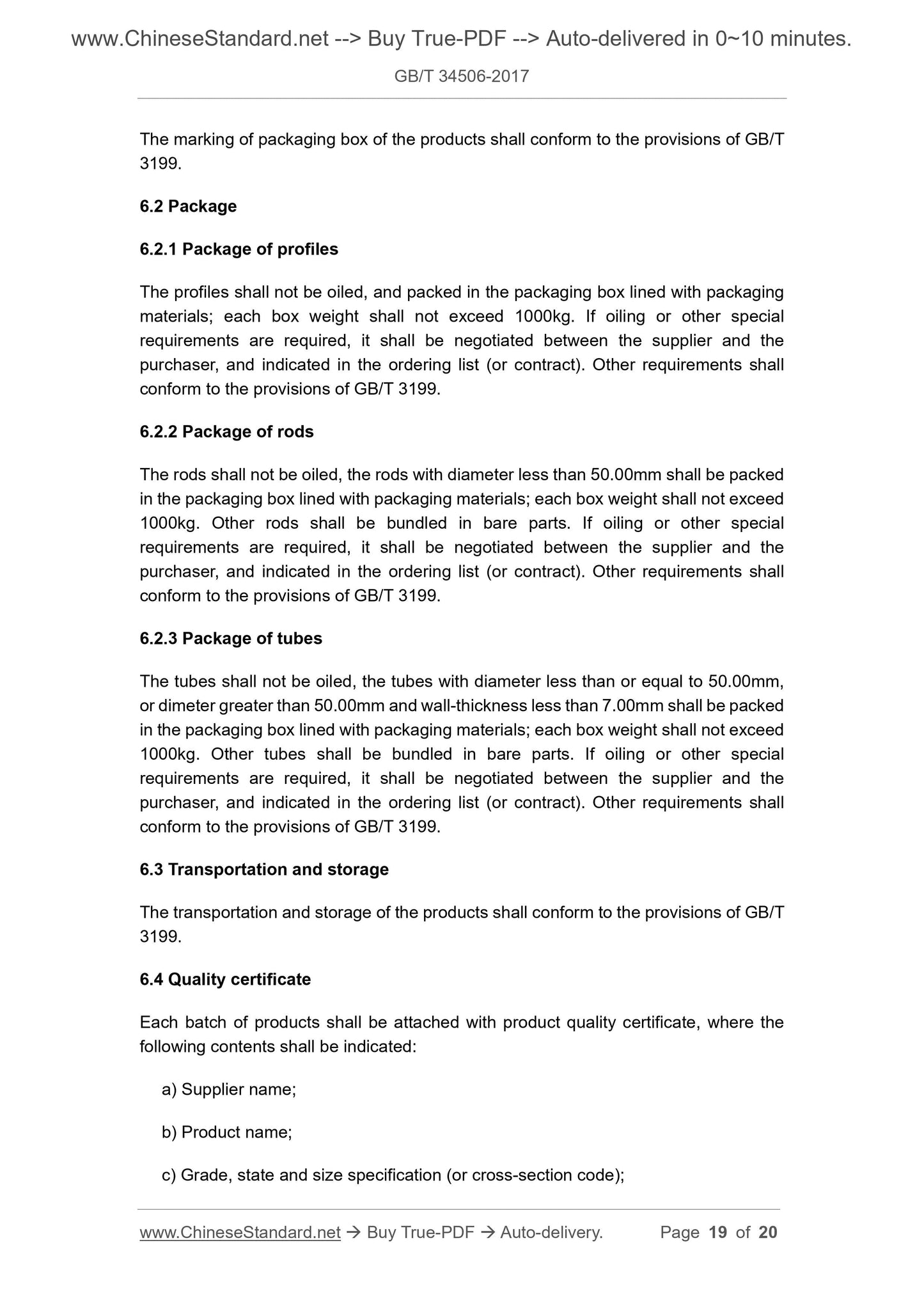1
/
of
9
www.ChineseStandard.us -- Field Test Asia Pte. Ltd.
GB/T 34506-2017 English PDF (GB/T34506-2017)
GB/T 34506-2017 English PDF (GB/T34506-2017)
Regular price
$150.00
Regular price
Sale price
$150.00
Unit price
/
per
Shipping calculated at checkout.
Couldn't load pickup availability
GB/T 34506-2017: Aluminum alloys extruded profiles, bars, rods and tubes from spray-formed billet
Delivery: 9 seconds. Download (& Email) true-PDF + Invoice.
Get Quotation: Click GB/T 34506-2017 (Self-service in 1-minute)
Historical versions (Master-website): GB/T 34506-2017
Preview True-PDF (Reload/Scroll-down if blank)
GB/T 34506-2017
NATIONAL STANDARD OF THE
PEOPLE’S REPUBLIC OF CHINA
ICS 77.150.10
H 61
Aluminum Alloys Extruded Profiles, Bars,
Rods and Tubes from Spray-Formed Billet
ISSUED ON: OCTOBER 14, 2017
IMPLEMENTED ON: MAY 01, 2018
Issued by: General Administration of Quality Supervision, Inspection and
Quarantine;
Standardization Administration of PRC.
Table of Contents
Foreword ... 3
1 Scope ... 4
2 Normative References ... 4
3 Requirements ... 5
4 Test Methods ... 12
5 Inspection Rules ... 14
6 Marking, Package, Transportation and Storage ... 17
7 Ordering List (or Contract) Contents ... 20
Aluminum Alloys Extruded Profiles, Bars,
Rods and Tubes from Spray-Formed Billet
1 Scope
This Standard specifies the requirements, test methods, inspection rules and marking,
package, transportation, storage and quality certificate, and ordering list (or contract)
contents of aluminum alloys extruded profiles, bars, rods and tubes from spray-formed
billet.
This Standard is applicable to the aluminum alloys extruded profiles, bars, rods and
tubes from spray-formed billet.
2 Normative References
The following documents are essential to the application of this document. For the
dated documents, only the versions with the dates indicated are applicable to this
document; for the undated documents, only the latest version (including all the
amendments) are applicable to this document.
GB/T 3190 Wrought Aluminum and Aluminum Alloys-Chemical Composition Limits
GB/T 3191 Extrusion Rods and Bars of Aluminum and Aluminum Alloy
GB/T 3199 Wrought Aluminum and Aluminum Alloy Products-Packing, Marking,
Transporting and Storing
GB/T 3246.1 Inspection Method for Structure of Wrought Aluminum and Aluminum
Alloy Products Part 1: Inspection Method for Microstructure
GB/T 3246.2 Inspection Method for Structure of Wrought Aluminum and Aluminum
Alloy Products - Part 2: Inspection Method for Macrostructure
GB/T 4436 Wrought Aluminum and Aluminum Alloy Tubes― Dimensions and
Deviations
GB/T 6519 Ultrasonic Testing Method for Products of Wrought Aluminum Alloy
GB/T 7999 Standard Method for Direct Reading Spectrometric Analysis of
Aluminum and Its Alloys
GB/T 8170 Rules of Rounding off for Numerical Values and Expression and
Judgement of Limiting Values
GB/T 12966 The Method for Determining Aluminum Alloys Conductivity Using
Eddy Current
GB/T 14846 Aluminum and Aluminum Alloy Extruded Profiles -- Tolerances on
Dimensions and Form
GB/T 16865 Test Pieces for Tensile Test for Wrought Aluminum and Magnesium
Alloy Products
GB/T 17432 Methods of Sampling for Analyzing the Chemical Composition of
Wrought Aluminum and Aluminum Alloy
GB/T 20975 (all parts) Methods for Chemical Analysis of Aluminum and Aluminum
Alloys
GB/T 22639 Test Method of Exfoliation Corrosion for Wrought Aluminum and
Aluminum Alloys
GB/T 33911-2017 4××× Aluminum Alloy Columniform Ingots
YS/T 845 Aluminum Alloy Round Billets by Spray Forming
3 Requirements
3.1 Product classification
3.1.1 Grade, state and size specification
The grade, state and size specification of the product shall conform to the provisions
of Table 1.
3.9 Microstructure
The microstructure is not allowed to have overfiring.
3.10 Ultrasonic flaw detection performance
When there are requirements for the ultrasonic flaw detection performance of the
product, it shall be negotiated between the supplier and the purchaser, and indicated
in the ordering list (or contract) for the ultrasonic inspection and inspection level.
3.11 Appearance quality
3.11.1 Profiles
3.11.1.1 No cracks, corrosion or non-metallic indentations are allowed on the surface
of the profiles.
3.11.1.2 The surface of the profile is not allowed to have the peelings, pits, indentations,
bubbles, bumps with depth greater than the negative deviation of the wall-thickness,
or scratches, surface roughness or individual abrasion with depth exceeding half
negative deviation of the wall-thickness. Within any length of 1m of the profile, the total
area of the defects shall not exceed 4% surface area of the profile.
3.11.1.3 The supplier is allowed to trim the surface defects of the profile in a longitudinal
direction until it becomes smooth. The trimming treatment shall not cause the wall
thickness to exceed the allowable range.
3.11.2 Rods
3.11.2.1 The rod surface is not allowed to have cracks, bubbles, and corrosive spots.
3.11.2.2 The depth of the defects such as peelings, pits, craters, bubbles, abrasions,
bumps, straightening marks, etc. on the rods surface is not allowed to exceed the
negative deviation of the diameter.
3.11.2.3 The defects on the rods surface are allowed to be ground; but the minimum
diameter of the rod shall be guaranteed.
3.11.3 Tubes
3.11.3.1 The surface of the tube shall be smooth, no cracks, bubbles or corrosive spots
are allowed.
3.11.3.2 The depth of the defects such as peelings, bubbles, abrasions, scratches,
bumps, pits, dents, etc. on the surface of the tubes shall not be allowed to exceed the
permissible deviation range of the inner and outer diameters of the tubes.
3.11.3.3 The surface of the tube is allowed to have defects such as extrusion flow
pattern, oxidation color caused by the mold.
3.11.3.4 The surface of the tube is allowed to have straightening spiral marks that do
not affect eh outer diameter size; but the dept shall not exceed 0.5mm.
4 Test Methods
4.1 Chemical composition
4.1.1 The analysis method of the chemical composition shall conform to the provisions
of GB/T 20975 or GB/T 7999; while the arbitration analysis shall adopt the method
specified in GB/T 20975.
4.1.2 Only perform the routine chemical analysis on the elements with specified values
beyond the columns “Al” and “other” with corresponding grades in Table 2 and GB/T
3190. When the mass fraction of the unconventional analytical elements is suspected
to exceed the limit of this Standard, the manufacturer shall analyze these elements.
4.1.3 The judgment of the analytical value is based on the round-off comparison
method; the numerical rounding-off shall be performed as per the provisions of GB/T
8170. The rounding-off digits shall be consistent with the limit digits specified in Table
2 or GB/T 3190.
4.2 Size deviation
4.2.1 Size deviation of profiles
4.2.1.1 When measuring the plane clearance of the profiles, firstly, place the profile on
the platform. When the profile becomes stable by its own weight, measure the
maximum clearance (F1) between the profile pane and the ruler by 100mm-long ruler
(or knife flat ruler), as shown in Figure 1; such value (F1) is the plane clearance of any
100mm-wide of the profile. Place the ruler (or knife flat ruler) with length greater than
the width of the profile along the width direction against the concave surface of the
profile; measure the maximum clearance (F) between the ruler and the profile. Or place
the concave surface of the profile on the platform; measure the maximum clearance
(F) between the profile and the platform along the width direction; as shown in Figure
1. Such value (F) is the plane clearance of the profile over the entire width.
4.5 Exfoliation corrosion performance
The test method for exfoliation corrosion performance shall be carried out as per the
provisions of GB/T 22639.
4.6 Macrostructure
The test method for macrostructure shall be carried out as per the provisions of GB/T
3246.2.
4.7 Microstructure
The test method for microstructure shall be carried out as per the provisions of GB/T
3246.1.
4.8 Ultrasonic inspection
The ultrasonic inspection method shall be carried out as per the provisions of GB/T
6519.
4.9 Appearance quality
Under natural scattered light, visually examine the appearance quality. If necessary,
the size of the defects shall be defined by a dimensional measurement tool; the depth
of the defect can be determined by grinding.
5 Inspection Rules
5.1 Inspection and acceptance
5.1.1 The product shall be inspected by the supplier, ensure that the product quality
complies with the provisions of this Standard and ordering list (or contract); and fill in
the quality certificate.
5.1.2 The purchaser shall inspection the received products as per the provisions of this
Standard. When the inspection result is inconsistent with the provisions of this
Standard and ordering list (or contract), it shall be submitted to the supplier in written
form, and settled through negotiation between the supplier and the purchaser. If it is
the objections on the appearance quality and size deviation, it shall be submitted within
1 month from the date of receipt of the product. If it is the objections on other
performances, it shall be submitted within 3 months from the date of receipt of the
product. If arbitration is required, it may be entrusted to the organization approved by
the supplier and the purchaser, and sample shall be jointly taken from the purchaser.
5.2 Batching
inspection.
5.6.4 If the conductivity of any sample is unqualified, then such batch of products is
judged as unqualified. If the exfoliation corrosion performance of such batch of
products is qualified, then conductivity shall not serve as the basis for rejection; and
such batch of products is judged as qualified.
5.6.5 If the exfoliation corrosion performance of any sample is unqualified, then such
batch of products is judged as unqualified.
5.6.6 When the macrostructure of any sample is unqualified, the judgement is as
follows:
a) If the products are unqualified due to the metallurgical defects such as cracks,
pores, bright grains, non-metallic inclusions, foreign metal inclusions, and oxide
film, then such batch of products is judged as unqualified.
b) When products are unqualified due to finished layer, shrinkage tail, coarse grain
ring, reinspection is allowed to be performed on the extrusion tail ends of the
product until it is qualified. Other products in such batch shall serve as the tested
products, which shall be cut the tail for maximum length as per the above defect
distribution, or inspect one by one, the qualified can be delivered.
c) If products are unqualified due to weld-seam of the hollow profiles, reinspection
is allowed to be performed on the hollow profile cutting a section of extrusion
front end until it is qualified. Other products in such batch shall serve as the
tested products, which shall be cut the head for maximum length as per the
above defect distribution, or inspect one by one, the qualified can be delivered.
5.6.7 If the microstructure of any sample is unqualified, then such batch of products is
judged as unqualified.
5.6.8 If the ultrasonic flow detection results of any sample is unqualified, then such
piece of product is judged as unqualified.
5.6.9 If the appearance quality of any sample is unqualified, then such piece of product
is judged as unqualified.
6 Marking, Package, Transportation and Storage
6.1 Marking
6.1.1 Product marking
6.1.1.1 Marking of profiles
The marking of packaging box of the products shall conform to the provisions of GB/T
3199.
6.2 Package
6.2.1 Package of profiles
The profiles shall not be oiled, and packed in the packaging box lined with packaging
materials; each box weight shall not exceed 1000kg. If oiling or other special
requirements are required, it shall be negotiated between the supplier and the
purchaser, and indicated in the ordering list (or contract). Other requirements shall
conform to the provisions of GB/T 3199.
6.2.2 Package of rods
The rods shall not be oiled, the rods with diameter less than 50.00mm shall be packed
in the packaging box lined with packaging materials; each box weight shall not exceed
1000kg. Other rods shall be bundled in bare parts. If oiling or other special
requirements are required, it shall be negotiated between the supplier and the
purchaser, and indicated in the ordering list (or contract). Other requirements shall
conform to the provisions of GB/T 3199.
6.2.3 Package of tubes
The tubes shall not be oiled, the tubes with diameter less than or equal to 50.00mm,
or dimeter greater than 50.00mm and wall-thickness less than 7.00mm shall be packed
in the packaging box lined with packaging materials; each box weight shall not exceed
1000kg. Other tubes shall be bundled in bare parts. If oiling or other special
requirements are required, it shall be negotiated between the supplier and the
purchaser, and indicated in the ordering list (or contract). Other requirements shall
conform to the provisions of GB/T 3199.
6.3 Transportation and storage
The transportation and storage of the products shall conform to the provisions of GB/T
3199.
6.4 Quality certificate
Each batch of products shall be attached with product quality certificate, where the
following contents shall be indicated:
a) Supplier name;
b) Product name;
c) Grade, state and size specification (or cross-section code);
GB/T 34506-2017
NATIONAL STANDARD OF THE
PEOPLE’S REPUBLIC OF CHINA
ICS 77.150.10
H 61
Aluminum Alloys Extruded Profiles, Bars,
Rods and Tubes from Spray-Formed Billet
ISSUED ON: OCTOBER 14, 2017
IMPLEMENTED ON: MAY 01, 2018
Issued by: General Administration of Quality Supervision, Inspection and
Quarantine;
Standardization Administration of PRC.
Table of Contents
Foreword ... 3
1 Scope ... 4
2 Normative References ... 4
3 Requirements ... 5
4 Test Methods ... 12
5 Inspection Rules ... 14
6 Marking, Package, Transportation and Storage ... 17
7 Ordering List (or Contract) Contents ... 20
Aluminum Alloys Extruded Profiles, Bars,
Rods and Tubes from Spray-Formed Billet
1 Scope
This Standard specifies the requirements, test methods, inspection rules and marking,
package, transportation, storage and quality certificate, and ordering list (or contract)
contents of aluminum alloys extruded profiles, bars, rods and tubes from spray-formed
billet.
Thi...
Delivery: 9 seconds. Download (& Email) true-PDF + Invoice.
Get Quotation: Click GB/T 34506-2017 (Self-service in 1-minute)
Historical versions (Master-website): GB/T 34506-2017
Preview True-PDF (Reload/Scroll-down if blank)
GB/T 34506-2017
NATIONAL STANDARD OF THE
PEOPLE’S REPUBLIC OF CHINA
ICS 77.150.10
H 61
Aluminum Alloys Extruded Profiles, Bars,
Rods and Tubes from Spray-Formed Billet
ISSUED ON: OCTOBER 14, 2017
IMPLEMENTED ON: MAY 01, 2018
Issued by: General Administration of Quality Supervision, Inspection and
Quarantine;
Standardization Administration of PRC.
Table of Contents
Foreword ... 3
1 Scope ... 4
2 Normative References ... 4
3 Requirements ... 5
4 Test Methods ... 12
5 Inspection Rules ... 14
6 Marking, Package, Transportation and Storage ... 17
7 Ordering List (or Contract) Contents ... 20
Aluminum Alloys Extruded Profiles, Bars,
Rods and Tubes from Spray-Formed Billet
1 Scope
This Standard specifies the requirements, test methods, inspection rules and marking,
package, transportation, storage and quality certificate, and ordering list (or contract)
contents of aluminum alloys extruded profiles, bars, rods and tubes from spray-formed
billet.
This Standard is applicable to the aluminum alloys extruded profiles, bars, rods and
tubes from spray-formed billet.
2 Normative References
The following documents are essential to the application of this document. For the
dated documents, only the versions with the dates indicated are applicable to this
document; for the undated documents, only the latest version (including all the
amendments) are applicable to this document.
GB/T 3190 Wrought Aluminum and Aluminum Alloys-Chemical Composition Limits
GB/T 3191 Extrusion Rods and Bars of Aluminum and Aluminum Alloy
GB/T 3199 Wrought Aluminum and Aluminum Alloy Products-Packing, Marking,
Transporting and Storing
GB/T 3246.1 Inspection Method for Structure of Wrought Aluminum and Aluminum
Alloy Products Part 1: Inspection Method for Microstructure
GB/T 3246.2 Inspection Method for Structure of Wrought Aluminum and Aluminum
Alloy Products - Part 2: Inspection Method for Macrostructure
GB/T 4436 Wrought Aluminum and Aluminum Alloy Tubes― Dimensions and
Deviations
GB/T 6519 Ultrasonic Testing Method for Products of Wrought Aluminum Alloy
GB/T 7999 Standard Method for Direct Reading Spectrometric Analysis of
Aluminum and Its Alloys
GB/T 8170 Rules of Rounding off for Numerical Values and Expression and
Judgement of Limiting Values
GB/T 12966 The Method for Determining Aluminum Alloys Conductivity Using
Eddy Current
GB/T 14846 Aluminum and Aluminum Alloy Extruded Profiles -- Tolerances on
Dimensions and Form
GB/T 16865 Test Pieces for Tensile Test for Wrought Aluminum and Magnesium
Alloy Products
GB/T 17432 Methods of Sampling for Analyzing the Chemical Composition of
Wrought Aluminum and Aluminum Alloy
GB/T 20975 (all parts) Methods for Chemical Analysis of Aluminum and Aluminum
Alloys
GB/T 22639 Test Method of Exfoliation Corrosion for Wrought Aluminum and
Aluminum Alloys
GB/T 33911-2017 4××× Aluminum Alloy Columniform Ingots
YS/T 845 Aluminum Alloy Round Billets by Spray Forming
3 Requirements
3.1 Product classification
3.1.1 Grade, state and size specification
The grade, state and size specification of the product shall conform to the provisions
of Table 1.
3.9 Microstructure
The microstructure is not allowed to have overfiring.
3.10 Ultrasonic flaw detection performance
When there are requirements for the ultrasonic flaw detection performance of the
product, it shall be negotiated between the supplier and the purchaser, and indicated
in the ordering list (or contract) for the ultrasonic inspection and inspection level.
3.11 Appearance quality
3.11.1 Profiles
3.11.1.1 No cracks, corrosion or non-metallic indentations are allowed on the surface
of the profiles.
3.11.1.2 The surface of the profile is not allowed to have the peelings, pits, indentations,
bubbles, bumps with depth greater than the negative deviation of the wall-thickness,
or scratches, surface roughness or individual abrasion with depth exceeding half
negative deviation of the wall-thickness. Within any length of 1m of the profile, the total
area of the defects shall not exceed 4% surface area of the profile.
3.11.1.3 The supplier is allowed to trim the surface defects of the profile in a longitudinal
direction until it becomes smooth. The trimming treatment shall not cause the wall
thickness to exceed the allowable range.
3.11.2 Rods
3.11.2.1 The rod surface is not allowed to have cracks, bubbles, and corrosive spots.
3.11.2.2 The depth of the defects such as peelings, pits, craters, bubbles, abrasions,
bumps, straightening marks, etc. on the rods surface is not allowed to exceed the
negative deviation of the diameter.
3.11.2.3 The defects on the rods surface are allowed to be ground; but the minimum
diameter of the rod shall be guaranteed.
3.11.3 Tubes
3.11.3.1 The surface of the tube shall be smooth, no cracks, bubbles or corrosive spots
are allowed.
3.11.3.2 The depth of the defects such as peelings, bubbles, abrasions, scratches,
bumps, pits, dents, etc. on the surface of the tubes shall not be allowed to exceed the
permissible deviation range of the inner and outer diameters of the tubes.
3.11.3.3 The surface of the tube is allowed to have defects such as extrusion flow
pattern, oxidation color caused by the mold.
3.11.3.4 The surface of the tube is allowed to have straightening spiral marks that do
not affect eh outer diameter size; but the dept shall not exceed 0.5mm.
4 Test Methods
4.1 Chemical composition
4.1.1 The analysis method of the chemical composition shall conform to the provisions
of GB/T 20975 or GB/T 7999; while the arbitration analysis shall adopt the method
specified in GB/T 20975.
4.1.2 Only perform the routine chemical analysis on the elements with specified values
beyond the columns “Al” and “other” with corresponding grades in Table 2 and GB/T
3190. When the mass fraction of the unconventional analytical elements is suspected
to exceed the limit of this Standard, the manufacturer shall analyze these elements.
4.1.3 The judgment of the analytical value is based on the round-off comparison
method; the numerical rounding-off shall be performed as per the provisions of GB/T
8170. The rounding-off digits shall be consistent with the limit digits specified in Table
2 or GB/T 3190.
4.2 Size deviation
4.2.1 Size deviation of profiles
4.2.1.1 When measuring the plane clearance of the profiles, firstly, place the profile on
the platform. When the profile becomes stable by its own weight, measure the
maximum clearance (F1) between the profile pane and the ruler by 100mm-long ruler
(or knife flat ruler), as shown in Figure 1; such value (F1) is the plane clearance of any
100mm-wide of the profile. Place the ruler (or knife flat ruler) with length greater than
the width of the profile along the width direction against the concave surface of the
profile; measure the maximum clearance (F) between the ruler and the profile. Or place
the concave surface of the profile on the platform; measure the maximum clearance
(F) between the profile and the platform along the width direction; as shown in Figure
1. Such value (F) is the plane clearance of the profile over the entire width.
4.5 Exfoliation corrosion performance
The test method for exfoliation corrosion performance shall be carried out as per the
provisions of GB/T 22639.
4.6 Macrostructure
The test method for macrostructure shall be carried out as per the provisions of GB/T
3246.2.
4.7 Microstructure
The test method for microstructure shall be carried out as per the provisions of GB/T
3246.1.
4.8 Ultrasonic inspection
The ultrasonic inspection method shall be carried out as per the provisions of GB/T
6519.
4.9 Appearance quality
Under natural scattered light, visually examine the appearance quality. If necessary,
the size of the defects shall be defined by a dimensional measurement tool; the depth
of the defect can be determined by grinding.
5 Inspection Rules
5.1 Inspection and acceptance
5.1.1 The product shall be inspected by the supplier, ensure that the product quality
complies with the provisions of this Standard and ordering list (or contract); and fill in
the quality certificate.
5.1.2 The purchaser shall inspection the received products as per the provisions of this
Standard. When the inspection result is inconsistent with the provisions of this
Standard and ordering list (or contract), it shall be submitted to the supplier in written
form, and settled through negotiation between the supplier and the purchaser. If it is
the objections on the appearance quality and size deviation, it shall be submitted within
1 month from the date of receipt of the product. If it is the objections on other
performances, it shall be submitted within 3 months from the date of receipt of the
product. If arbitration is required, it may be entrusted to the organization approved by
the supplier and the purchaser, and sample shall be jointly taken from the purchaser.
5.2 Batching
inspection.
5.6.4 If the conductivity of any sample is unqualified, then such batch of products is
judged as unqualified. If the exfoliation corrosion performance of such batch of
products is qualified, then conductivity shall not serve as the basis for rejection; and
such batch of products is judged as qualified.
5.6.5 If the exfoliation corrosion performance of any sample is unqualified, then such
batch of products is judged as unqualified.
5.6.6 When the macrostructure of any sample is unqualified, the judgement is as
follows:
a) If the products are unqualified due to the metallurgical defects such as cracks,
pores, bright grains, non-metallic inclusions, foreign metal inclusions, and oxide
film, then such batch of products is judged as unqualified.
b) When products are unqualified due to finished layer, shrinkage tail, coarse grain
ring, reinspection is allowed to be performed on the extrusion tail ends of the
product until it is qualified. Other products in such batch shall serve as the tested
products, which shall be cut the tail for maximum length as per the above defect
distribution, or inspect one by one, the qualified can be delivered.
c) If products are unqualified due to weld-seam of the hollow profiles, reinspection
is allowed to be performed on the hollow profile cutting a section of extrusion
front end until it is qualified. Other products in such batch shall serve as the
tested products, which shall be cut the head for maximum length as per the
above defect distribution, or inspect one by one, the qualified can be delivered.
5.6.7 If the microstructure of any sample is unqualified, then such batch of products is
judged as unqualified.
5.6.8 If the ultrasonic flow detection results of any sample is unqualified, then such
piece of product is judged as unqualified.
5.6.9 If the appearance quality of any sample is unqualified, then such piece of product
is judged as unqualified.
6 Marking, Package, Transportation and Storage
6.1 Marking
6.1.1 Product marking
6.1.1.1 Marking of profiles
The marking of packaging box of the products shall conform to the provisions of GB/T
3199.
6.2 Package
6.2.1 Package of profiles
The profiles shall not be oiled, and packed in the packaging box lined with packaging
materials; each box weight shall not exceed 1000kg. If oiling or other special
requirements are required, it shall be negotiated between the supplier and the
purchaser, and indicated in the ordering list (or contract). Other requirements shall
conform to the provisions of GB/T 3199.
6.2.2 Package of rods
The rods shall not be oiled, the rods with diameter less than 50.00mm shall be packed
in the packaging box lined with packaging materials; each box weight shall not exceed
1000kg. Other rods shall be bundled in bare parts. If oiling or other special
requirements are required, it shall be negotiated between the supplier and the
purchaser, and indicated in the ordering list (or contract). Other requirements shall
conform to the provisions of GB/T 3199.
6.2.3 Package of tubes
The tubes shall not be oiled, the tubes with diameter less than or equal to 50.00mm,
or dimeter greater than 50.00mm and wall-thickness less than 7.00mm shall be packed
in the packaging box lined with packaging materials; each box weight shall not exceed
1000kg. Other tubes shall be bundled in bare parts. If oiling or other special
requirements are required, it shall be negotiated between the supplier and the
purchaser, and indicated in the ordering list (or contract). Other requirements shall
conform to the provisions of GB/T 3199.
6.3 Transportation and storage
The transportation and storage of the products shall conform to the provisions of GB/T
3199.
6.4 Quality certificate
Each batch of products shall be attached with product quality certificate, where the
following contents shall be indicated:
a) Supplier name;
b) Product name;
c) Grade, state and size specification (or cross-section code);
GB/T 34506-2017
NATIONAL STANDARD OF THE
PEOPLE’S REPUBLIC OF CHINA
ICS 77.150.10
H 61
Aluminum Alloys Extruded Profiles, Bars,
Rods and Tubes from Spray-Formed Billet
ISSUED ON: OCTOBER 14, 2017
IMPLEMENTED ON: MAY 01, 2018
Issued by: General Administration of Quality Supervision, Inspection and
Quarantine;
Standardization Administration of PRC.
Table of Contents
Foreword ... 3
1 Scope ... 4
2 Normative References ... 4
3 Requirements ... 5
4 Test Methods ... 12
5 Inspection Rules ... 14
6 Marking, Package, Transportation and Storage ... 17
7 Ordering List (or Contract) Contents ... 20
Aluminum Alloys Extruded Profiles, Bars,
Rods and Tubes from Spray-Formed Billet
1 Scope
This Standard specifies the requirements, test methods, inspection rules and marking,
package, transportation, storage and quality certificate, and ordering list (or contract)
contents of aluminum alloys extruded profiles, bars, rods and tubes from spray-formed
billet.
Thi...
Share
